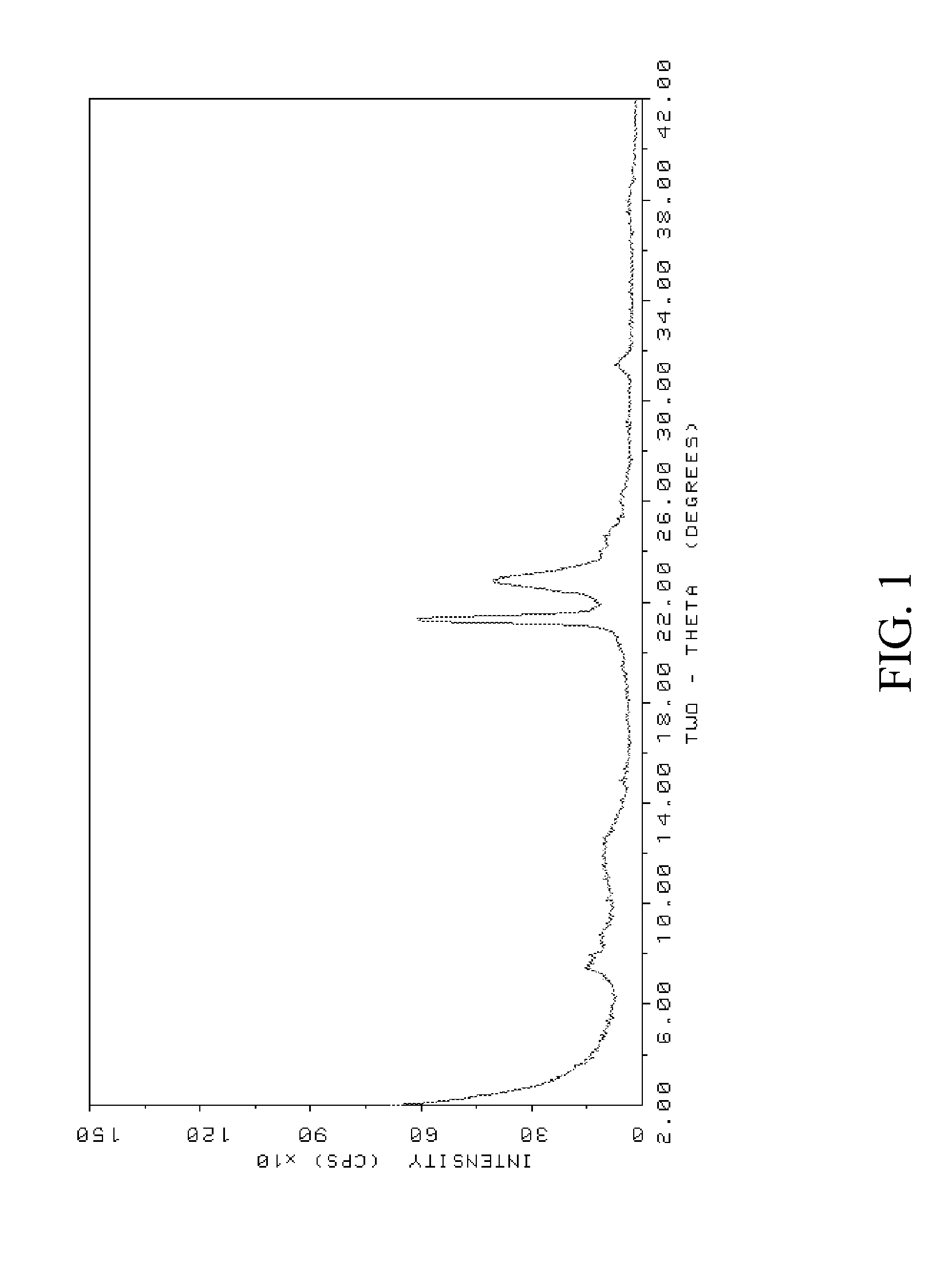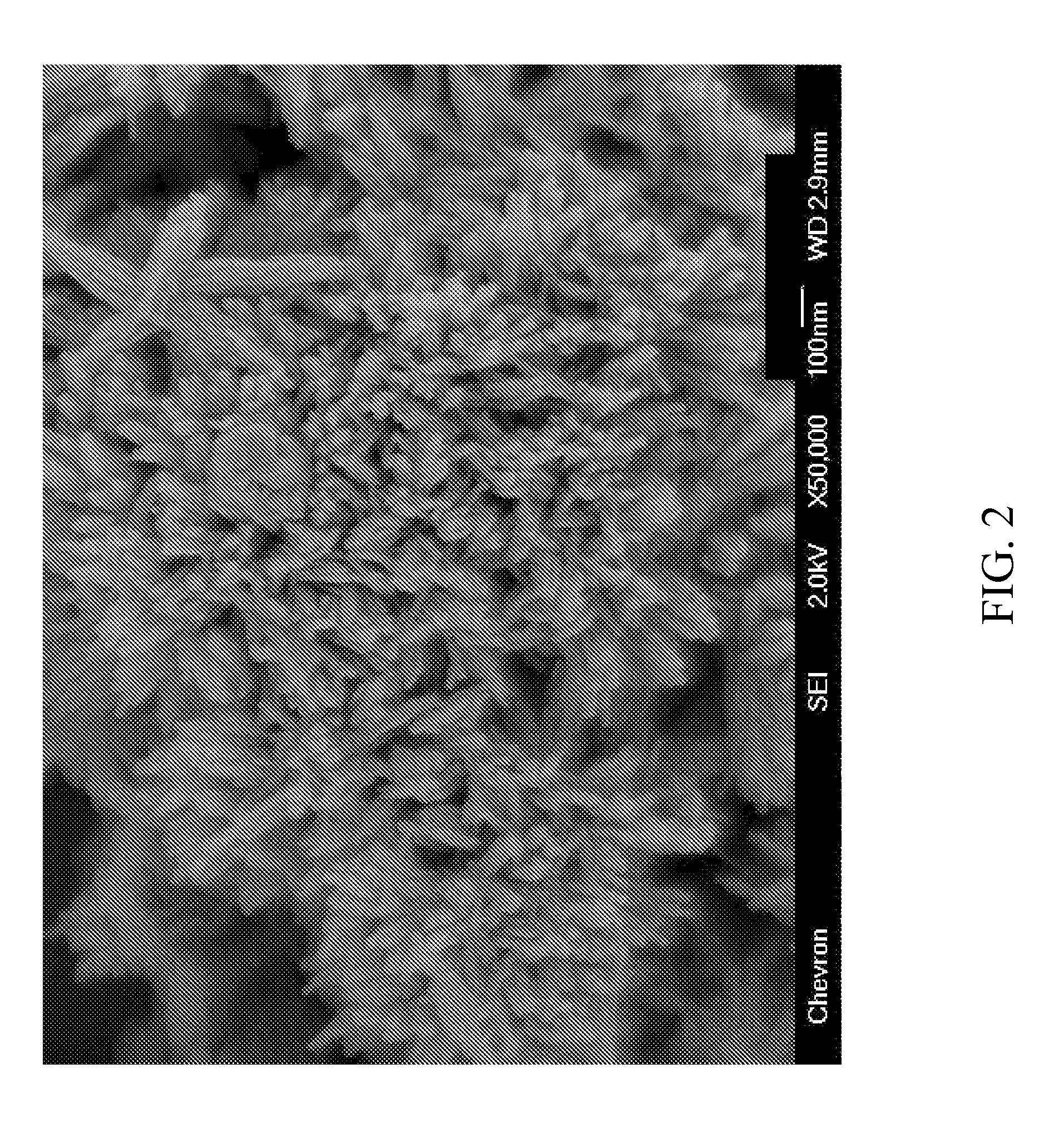Method for making borosilicate zsm-48 molecular sieves
a molecular sieve and borosilicate technology, applied in the field of borosilicate zsm48, can solve the problems of minor shift in the powder xrd pattern, significant peak broadening,
- Summary
- Abstract
- Description
- Claims
- Application Information
AI Technical Summary
Benefits of technology
Problems solved by technology
Method used
Image
Examples
example 1
Synthesis of Borosilicate ZSM-48 Using an SDA of Structure (1), n=8
[0080]4.69 g of an aqueous solution of 1,8-bis(trimethylammonium)octane hydroxide ([OH−]=0.64 mmol / g), 0.37 g of potassium iodide, and 6.51 g of deionized water were mixed together. Then 0.035 g of potassium tetraborate decahydrate (KTB) was dissolved in the solution, and 0.90 g of CAB-O-SIL M-5 fumed silica (Cabot Corporation, Boston, Mass.) was added and mixed to form a uniform suspension. The suspension was placed in a Teflon cup, capped, and sealed within a 23-ml stainless steel Parr autoclave. The autoclave was placed in a spit within an oven at a temperature of 160° C. and mixed at 43 rpm for 8 days. The reactor was removed from the oven, allowed to cool, and the solids were collected by filtration and washing with deionized water. The solids were then allowed to dry in an oven at 95° C.
[0081]The molecular sieve product of Example 1 was analyzed by powder XRD, inductively coupled plasma—optical emission spectro...
example 2
Synthesis of Borosilicate ZSM-48 Using an SDA of Structure (1), n=9
[0082]6.87 g of an aqueous solution of 1,9-bis(trimethylammonium)nonane hydroxide ([OH−]=0.44 mmol / g), 0.37 g of potassium iodide, and 4.33 g of deionized water were mixed together. Then 0.035 g of KTB was dissolved in the solution, and 0.90 g of CAB-O-SIL M-5 fumed silica was added and mixed to form a uniform suspension. The suspension was placed in a Teflon cup, capped, and sealed within a 23-ml stainless steel Parr autoclave. The autoclave was placed in a spit in an oven at a temperature of 160° C. and mixed at 43 rpm for 8 days. The reactor was removed from the oven, allowed to cool, and the solids were collected by filtration and washing with deionized water. The solids were then allowed to dry in an oven at 95° C.
[0083]The resulting powder XRD pattern, as shown in FIG. 3, identified the molecular sieve product of Example 2 as borosilicate ZSM-48. Again, the XRD pattern exhibited unusually broad peaks as compare...
example 3
Synthesis of Borosilicate ZSM-48 Using an SDA of Structure (1), n=10
[0084]0.63 g of 1,10-bis(trimethylammonium)decane dibromide, 3.00 g of 1N KOH, and 7.80 g of deionized water were mixed together. Then 0.035 g of KTB was dissolved in the solution, and 0.90 g of CAB-O-SIL M-5 fumed silica was added and mixed to form a uniform suspension. The suspension was placed in a Teflon cup, capped, and sealed within a 23-ml stainless steel Parr autoclave. The autoclave was placed in a spit within an oven heated at 160° C. and mixed at 43 rpm for 8 days. The reactor was removed from the oven, allowed to cool, and the solids were collected by filtration and washing with deionized water. The solids were then allowed to dry in an oven at 95° C. The molecular sieve product of Example 3, which was identified from powder XRD data as borosilicate ZSM-48, was broadly similar to that of Example 2.
[0085]The preparation of Example 3 was repeated using 0.070 g KTB instead of 0.035 g KTB, with broadly simil...
PUM
| Property | Measurement | Unit |
|---|---|---|
| Thickness | aaaaa | aaaaa |
| Thickness | aaaaa | aaaaa |
| Thickness | aaaaa | aaaaa |
Abstract
Description
Claims
Application Information
 Login to View More
Login to View More - R&D
- Intellectual Property
- Life Sciences
- Materials
- Tech Scout
- Unparalleled Data Quality
- Higher Quality Content
- 60% Fewer Hallucinations
Browse by: Latest US Patents, China's latest patents, Technical Efficacy Thesaurus, Application Domain, Technology Topic, Popular Technical Reports.
© 2025 PatSnap. All rights reserved.Legal|Privacy policy|Modern Slavery Act Transparency Statement|Sitemap|About US| Contact US: help@patsnap.com



